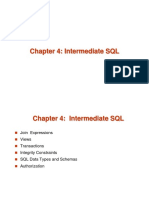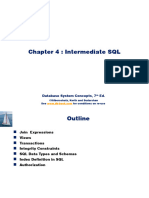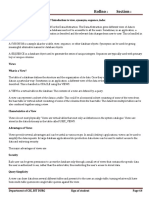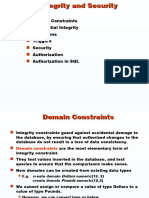0% found this document useful (0 votes)
47 views52 pagesIntermediate SQL
The document discusses intermediate SQL concepts including join expressions, views, transactions, integrity constraints, and data types. Join expressions combine data from multiple tables and include inner, outer, left, right, and full joins. Views allow users to query virtual tables defined by SQL expressions. Transactions ensure atomicity and isolation when making multiple related changes to a database. Integrity constraints like not null, unique, primary key, foreign key, and check clauses maintain data validity.
Uploaded by
Kamatchi KartheebanCopyright
© © All Rights Reserved
We take content rights seriously. If you suspect this is your content, claim it here.
Available Formats
Download as PPT, PDF, TXT or read online on Scribd
0% found this document useful (0 votes)
47 views52 pagesIntermediate SQL
The document discusses intermediate SQL concepts including join expressions, views, transactions, integrity constraints, and data types. Join expressions combine data from multiple tables and include inner, outer, left, right, and full joins. Views allow users to query virtual tables defined by SQL expressions. Transactions ensure atomicity and isolation when making multiple related changes to a database. Integrity constraints like not null, unique, primary key, foreign key, and check clauses maintain data validity.
Uploaded by
Kamatchi KartheebanCopyright
© © All Rights Reserved
We take content rights seriously. If you suspect this is your content, claim it here.
Available Formats
Download as PPT, PDF, TXT or read online on Scribd
/ 52



















































































